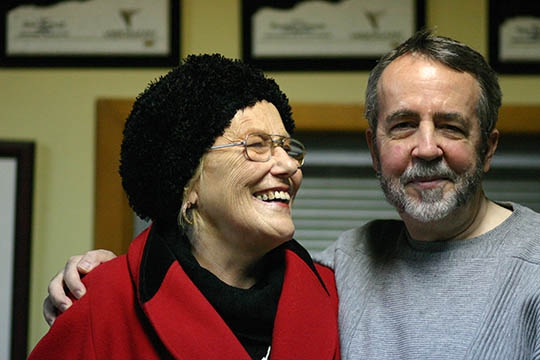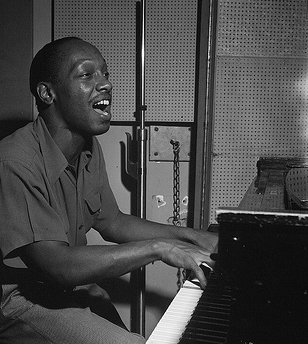Sweet Life – Tadd Dameron
A lush ballad with the classic Dameron touch. It was never recorded during his lifetime, but was brought to life in a recent recording by saxophonist Houston Person. Our own Minus You version is also available.
- Recording: Houston Person - Nice 'n' Easy
- Recorded on: July 3, 2013
- Label: HighNote (HCD 7257)
- Concert Key: F
- Vocal Range: , to
- Style: Ballad
- Tenor Sax - Houston Person
- Vibes - Chuck Redd
- Piano - John Di Martino
- Bass - Ray Drummond
- Drums - Lewis Nash
0:00
0:00
Buy MP3
Video
- Description
- Historical Notes
- Solos
- Piano Corner
- Bass Corner
- Drum Corner
- Guitar Corner
- Inside & Beyond
- Minus You
This lush, mellow ballad is a welcome addition to the Dameron canon. Like many of his ballads, the melody often lands on the upper extensions of the chords; for example D, the 6th (or 13th) of Fmaj7 in the first measure and C, the 4th (or 11th) of Gm7 in the third measure. The harmonies contain several tasty chromatic approaches and tritone substitutions. This song has a 32-measure AABC form, with the C section using largely the same changes as A but a variation of the melody.
Our lead sheet shows the changes largely as they appear in Tadd's original solo piano arrangement (click on the Piano Corner tab for more details). This Houston Person recording has several important differences. The second chord in both the second and fourth measures is played on beat 3, while on the lead sheet these chords are on beat 2 and line up with the melody. The rhythmic placement of the chord symbol notation in our lead sheet editions comes from Tadd's original voiced piano manuscript, where Tadd hears the chords as lining up precisely with specific melody notes' rhythms. Houston Person approached the chord progression in a more standard two-beat way.
The fourth measure differs further from the lead sheet in its third chord, which appears on beat 4: E7 is played instead of the C7 shown in the lead sheet, to link E♭7 and Fmaj7. On the recording the 7th measure of the second A section has E♭7 on beats 3 and 4, replacing the lead sheet's Gm7 to C7. In the third measure of the bridge, G♭7♭5 is substituted for C7♯5(♯9) on the recording. Finally, the 5th measure of the C section contains a classic Dameron stepwise walk-up from F to A in the lead sheet, but in the recording only A7 and D7 are played.
Lyricist Bernie Hanighen (of 'Round Midnight fame) collaborated with Dameron on a few songs; this is one, and you can hear vocalist Richard Allen's take on it only on jazzleadsheets.com.
Our lead sheet shows the changes largely as they appear in Tadd's original solo piano arrangement (click on the Piano Corner tab for more details). This Houston Person recording has several important differences. The second chord in both the second and fourth measures is played on beat 3, while on the lead sheet these chords are on beat 2 and line up with the melody. The rhythmic placement of the chord symbol notation in our lead sheet editions comes from Tadd's original voiced piano manuscript, where Tadd hears the chords as lining up precisely with specific melody notes' rhythms. Houston Person approached the chord progression in a more standard two-beat way.
The fourth measure differs further from the lead sheet in its third chord, which appears on beat 4: E7 is played instead of the C7 shown in the lead sheet, to link E♭7 and Fmaj7. On the recording the 7th measure of the second A section has E♭7 on beats 3 and 4, replacing the lead sheet's Gm7 to C7. In the third measure of the bridge, G♭7♭5 is substituted for C7♯5(♯9) on the recording. Finally, the 5th measure of the C section contains a classic Dameron stepwise walk-up from F to A in the lead sheet, but in the recording only A7 and D7 are played.
Lyricist Bernie Hanighen (of 'Round Midnight fame) collaborated with Dameron on a few songs; this is one, and you can hear vocalist Richard Allen's take on it only on jazzleadsheets.com.
The players on this album, with the exception of vibraphonist Chuck Redd, are regular users of the rehearsal studio at jazzleadsheets.com. Person, who has a close relationship with the Sicklers and also with engineer Rudy Van Gelder. Houston knows that the Sickler publishing archives have lots of great songs that have his name written all over them, so he is always asking Don "What have you got for me?" when he's ready to record. For this album, Don Sickler gave him the opportunity to be the first to record Tadd's Sweet Life.
Tadd Dameron's Solo Piano Arrangement with melody & lyric
This song was not recorded during Tadd's lifetime. Therefore, we are very fortunate that he deposited a carefully notated piano arrangement at the Copyright Office. It is harmonized mostly with widespread four- and five-note voicings, a Dameron specialty. Some of the short eighth-note lines that connect the longer melody notes are doubled an octave below in the left hand. The second chords of the second and fourth measures appear on beat 2, clearly following the melody rather than continuing the pattern of a chord every two beats.
Tadd's terminology for the chord symbols is at times somewhat unusual. Most notably, he uses F♯7♭5 as the symbol for the first and third measures of the bridge, even though the chord does not contain an F♯; if that note were added in the bass it would be that chord, but without it the combination of notes is the same as the tritone substitute chord C7♯5(♯9). Our Solo Piano Arrangement has this latter chord symbol notated, with F♯7♭5 written below the staff.
The other important idiosyncracy of Tadd's chord symbol nomenclature in this chart concerns the bebop usage of the m7♭5 or "half-diminished" chord. The second measure begins with a chord whose standard symbol is Am7♭5, but in Tadd's manuscript (and indicated below the staff in our version) it is Cm6. This was the early beboppers' name for this chord, a minor sixth chord with the sixth as the bass note. Thelonious Monk and Dizzy Gillespie, as well as Dameron, started to experiment with this in the early '40s. There is a classic quote about this chord quality from Dizzy's autobiography, "To Be Or Not To Bop:" "Monk showed it to me, and he called it a minor-sixth chord with the sixth in the bass. Nowadays, they don't call it that. They call the sixth in the bass, the tonic, and the chord a minor seventh, flat five. What Monk called an E♭-minor sixth chord with the sixth in the bass, the guys nowadays call a C-minor seventh flat five." It's a chord substitution that comes ultimately from the older interpretation of a II-V7-I progression as IV-V7-I. In this case the IV's quality is changed from major to minor; when the second of the tonic key (I) is used as the root of this chord instead of the 4th, the result is a m7♭5 chord quality.
This song was not recorded during Tadd's lifetime. Therefore, we are very fortunate that he deposited a carefully notated piano arrangement at the Copyright Office. It is harmonized mostly with widespread four- and five-note voicings, a Dameron specialty. Some of the short eighth-note lines that connect the longer melody notes are doubled an octave below in the left hand. The second chords of the second and fourth measures appear on beat 2, clearly following the melody rather than continuing the pattern of a chord every two beats.
Tadd's terminology for the chord symbols is at times somewhat unusual. Most notably, he uses F♯7♭5 as the symbol for the first and third measures of the bridge, even though the chord does not contain an F♯; if that note were added in the bass it would be that chord, but without it the combination of notes is the same as the tritone substitute chord C7♯5(♯9). Our Solo Piano Arrangement has this latter chord symbol notated, with F♯7♭5 written below the staff.
The other important idiosyncracy of Tadd's chord symbol nomenclature in this chart concerns the bebop usage of the m7♭5 or "half-diminished" chord. The second measure begins with a chord whose standard symbol is Am7♭5, but in Tadd's manuscript (and indicated below the staff in our version) it is Cm6. This was the early beboppers' name for this chord, a minor sixth chord with the sixth as the bass note. Thelonious Monk and Dizzy Gillespie, as well as Dameron, started to experiment with this in the early '40s. There is a classic quote about this chord quality from Dizzy's autobiography, "To Be Or Not To Bop:" "Monk showed it to me, and he called it a minor-sixth chord with the sixth in the bass. Nowadays, they don't call it that. They call the sixth in the bass, the tonic, and the chord a minor seventh, flat five. What Monk called an E♭-minor sixth chord with the sixth in the bass, the guys nowadays call a C-minor seventh flat five." It's a chord substitution that comes ultimately from the older interpretation of a II-V7-I progression as IV-V7-I. In this case the IV's quality is changed from major to minor; when the second of the tonic key (I) is used as the root of this chord instead of the 4th, the result is a m7♭5 chord quality.
Related Songs
Email Send Sweet Life to a friend
Send this page to a friend via email. Add your name or email in the first field. In the second, add one or more email addresses, separated by a comma.
- Recording: Don Sickler - Further Explorations Vol. 1
- Recorded on: September 13, 1997
- Label: jazzleadsheets.com (JLS 1034)
- Concert Key: A-flat
- Vocal Range: , to
- Style: Ballad
- Muted Trumpet/Flugelhorn - Don Sickler
- Piano - Norman Simmons
- Bass - Ron McClure
- Drums - Billy Drummond
Video
- Description
- Historical Notes
- Solos
- Piano Corner
- Bass Corner
- Drum Corner
- Guitar Corner
- Inside & Beyond
- Minus You
Don Sickler took the opportunity presented by the 1997 vocal recording of this composition (see the "Tadd Dameron Songbook featuring Richard Allen") to add both muted trumpet and flugelhorn melodies and improvisations to the accompaniment track.
This Minus You version in the key of A♭ is again slightly different harmonically from the original lead sheet. Like in Houston Person's recording (above left), the second and fourth measures have their second chords on beat 3 instead of beat 2. Often D♭maj7 is played or implied on the third beat of the first measure in both A and C sections. The last two measures of the second A section again include a descent to the ♭VII (G♭7), followed this time by stepwise ascending chords to E♭7 at the beginning of the bridge. The tritone substitution as in Houston Person's version appears in the third measure of the bridge. The fifth measure of the C section, however, has the same changes as Tadd's original lead sheet.
The melody lines of Norman Simmons' piano intro and ending are notated in this lead sheet. The flugelhorn feature track is a two- chorus recording, with a piano solo for the first two A sections of the second chorus. The muted trumpet track is one and a half choruses, the same format as our Minus You track: After the first melody chorus it goes back to the bridge for a muted trumpet solo and then returns to the melody after the bridge.
This Minus You version in the key of A♭ is again slightly different harmonically from the original lead sheet. Like in Houston Person's recording (above left), the second and fourth measures have their second chords on beat 3 instead of beat 2. Often D♭maj7 is played or implied on the third beat of the first measure in both A and C sections. The last two measures of the second A section again include a descent to the ♭VII (G♭7), followed this time by stepwise ascending chords to E♭7 at the beginning of the bridge. The tritone substitution as in Houston Person's version appears in the third measure of the bridge. The fifth measure of the C section, however, has the same changes as Tadd's original lead sheet.
The melody lines of Norman Simmons' piano intro and ending are notated in this lead sheet. The flugelhorn feature track is a two- chorus recording, with a piano solo for the first two A sections of the second chorus. The muted trumpet track is one and a half choruses, the same format as our Minus You track: After the first melody chorus it goes back to the bridge for a muted trumpet solo and then returns to the melody after the bridge.
"Further Explorations" was recorded at the legendary Van Gelder Studio in Englewood Cliffs.
Mia Dameron, Tadd's widow, often visited the jazzleadsheets.com studio when she came to the US, sometimes staying overnight on our rehearsal room couch. She brought some shapshots taken of Tadd while they were living at the Hotel Almanac on Broadway; one was the source of the photo of Tadd holding a cigarette on the "Tadd Dameron Songbook."
Don and Mia became great friends:
Mia Dameron, Tadd's widow, often visited the jazzleadsheets.com studio when she came to the US, sometimes staying overnight on our rehearsal room couch. She brought some shapshots taken of Tadd while they were living at the Hotel Almanac on Broadway; one was the source of the photo of Tadd holding a cigarette on the "Tadd Dameron Songbook."
Don and Mia became great friends:

Exclusive Minus You audio track
CLIP This recording is a chorus and a half long. After the piano intro, the soloist plays the melody, followed by a repeat of the B and C sections. A soloist can improvise on the second B or play the melody again.
CLIP This recording is a chorus and a half long. After the piano intro, the soloist plays the melody, followed by a repeat of the B and C sections. A soloist can improvise on the second B or play the melody again.
Related Songs
Email Send Sweet Life to a friend
Send this page to a friend via email. Add your name or email in the first field. In the second, add one or more email addresses, separated by a comma.

Tadd Dameron
February 21, 1917 – March 8, 1965
A giant of the bebop era, Dameron had a wonderful melodic and harmonic imagination which he brought to compositions and arrangements for both small and big bands. Writing first for Harlan Leonard, Jimmy Lunceford, Count Basie and Billy Eckstine, in the late '40s Dameron started composing and arranging for Dizzy Gillespie's big band. He also recorded his own superb sextet for Blue Note Records in 1947 which featured trumpet great Fats Navarro. Read more...
There was a problem.
...


